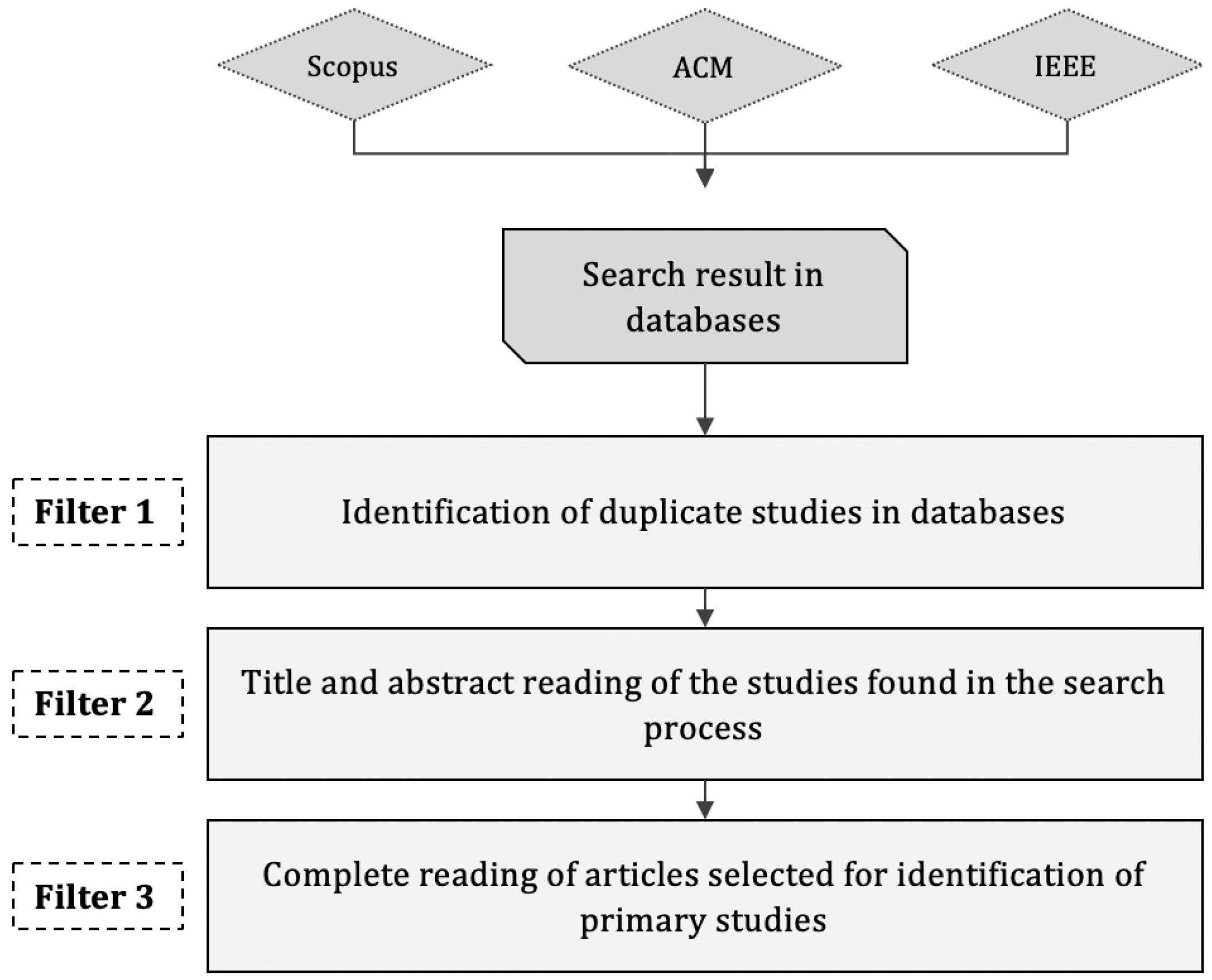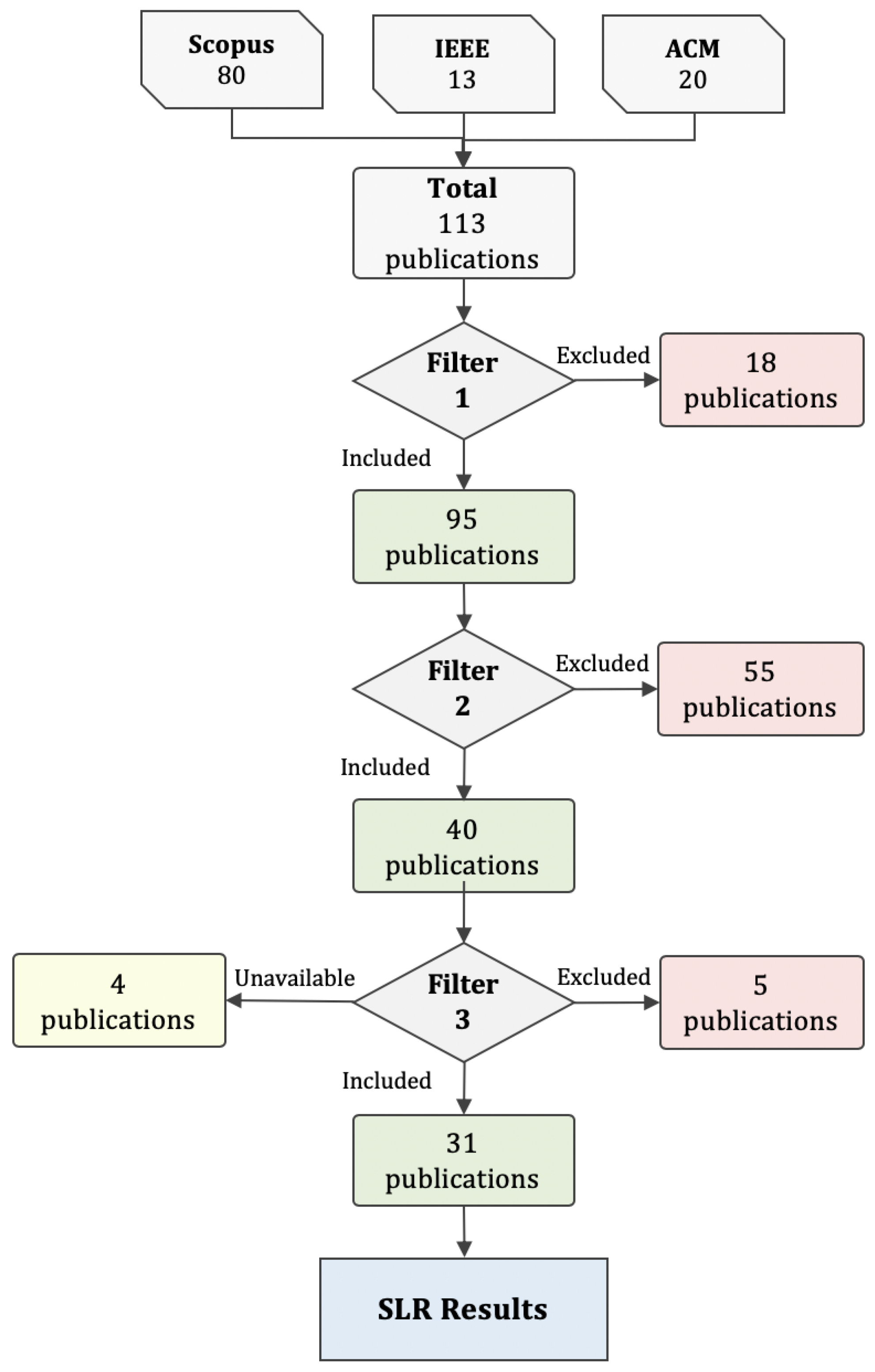Author Contributions
Conceptualization, G.V.P., V.G.d.M., and M.P.P.d.S.; methodology, G.V.P. and V.G.d.M.; validation, V.G.d.M. and M.P.P.d.S.; formal analysis, V.G.d.M. and G.V.P.; investigation, V.G.d.M. and G.V.P.; data curation, G.V.P. and V.G.d.M.; writing—original draft preparation, G.V.P. and V.G.d.M.; writing—review and editing, G.V.P.; supervision, R.M.d.C.F.; project administration, R.M.d.C.F. All authors have read and agreed to the published version of the manuscript.
Funding
This research is part of a cooperation agreement between the Information Technology Research and Application Center (ITRAC) and the Brazilian Ministry of Economy.
Conflicts of Interest
The authors declare no conflict of interest.
Abbreviations
The following abbreviations are used in this manuscript:
| ACSI | American Customer Satisfaction Index |
| D&M | DeLone and McLean Model |
| EC | Exclusion Criteria |
| ECSI | European Customer Satisfaction Index |
| IC | Inclusion Criteria |
| IS | Information Systems |
| MQ | Main Question |
| PCA | Principal Component Analysis |
| SEM | Structural Equation Modeling |
| SERVQUAL | Service Quality Model |
| SLR | Systematic Literature Review |
| SQ | Secondary Question |
| TAM | Technology Acceptance Model |
| UTAUT | Unified Theory of Acceptance and Use of Technology |
| XE | Experience Effectiveness |
References
- Gardenghi, J.L.; Pereira, L.G.; Alcantara, S.M.; Figueiredo, R.M.C.; Ramos, C.S.; Ribeiro, L.C.M. Digitalization by Means of a Prototyping Process: The Case of a Brazilian Public Service. Information 2020, 11, 413. [Google Scholar] [CrossRef]
- Floropoulos, J.; Spathis, C.; Halvatzis, D.; Tsipouridou, M. Measuring the Success of the Greek Taxation Information System. Int. J. Inf. Manag. 2010, 30, 47–56. [Google Scholar] [CrossRef]
- Soares, V.d.A.; Iwama, G.Y.; Menezes, V.G.; Gomes, M.M.F.; Pedrosa, G.V.; Silva, W.C.M.P.d.; Figueiredo, R.M.D.C. Evaluating Government Services Based on User Perspective. In Proceedings of the 20th Annual International Conference on Digital Government Research, Dubai, United Arab Emirates, 18–20 June 2019; Association for Computing Machinery: New York, NY, USA, 2019; pp. 425–432. [Google Scholar] [CrossRef]
- Pedrosa, G.; Menezes, V.; Figueiredo, R. A Quality Management-Based Approach to Evaluate Public Services: A Case Study in Brazil. In Proceedings of the 53rd Hawaii International Conference on System Sciences, HICSS 2020, Maui, HI, USA, 7–10 January 2020. [Google Scholar] [CrossRef]
- Parasuraman, A.; Zeithaml, V.A.; Berry, L.L. A Conceptual Model of Service Quality and Its Implications for Future Research. J. Mark. 1985, 49, 41. [Google Scholar] [CrossRef]
- Parasuraman, A.; Zeithaml, V.A.; Berry, L.L. SERVQUAL: A Multiple-Item Scale for Measuring Consumer Perceptions of Service Quality. J. Retail. 1988, 64, 12–40. [Google Scholar]
- Davis, F.D.; Bagozzi, R.P.; Warshaw, P.R. User Acceptance of Computer Technology: A Comparison of Two Theoretical Models. Manag. Sci. 1989, 35, 982–1003. [Google Scholar] [CrossRef]
- DeLone, W.H.; McLean, E.R. The DeLone and McLean Model of Information Systems Success: A Ten-Year Update. J. Manag. Inf. Syst. 2003, 19, 9–30. [Google Scholar]
- Parasuraman, A.; Zeithaml, V.A.; Malhotra, A. E-S-QUAL: A Multiple-Item Scale for Assessing Electronic Service Quality. J. Serv. Res. 2005, 7, 213–233. [Google Scholar] [CrossRef]
- Pedrosa, G.V.; Kosloski, R.A.D.; Menezes, V.G.d.; Iwama, G.Y.; Silva, W.C.M.P.d.; Figueiredo, R.M.d.C. A Systematic Review of Indicators for Evaluating the Effectiveness of Digital Public Services. Information 2020, 11, 472. [Google Scholar] [CrossRef]
- Kitchenham, B.; Charters, S. Guidelines for Performing Systematic Literature Reviews in Software Engineering; Keele University and Durham University Joint Report; Keele University: Keele, UK, 2007. [Google Scholar]
- Brereton, P.; Kitchenham, B.A.; Budgen, D.; Turner, M.; Khalil, M. Lessons from Applying the Systematic Literature Review Process within the Software Engineering Domain. J. Syst. Softw. 2007, 80, 571–583. [Google Scholar] [CrossRef]
- Kitchenham, B. Procedures for Performing Systematic Reviews; Keele University: Keele, UK, 2004; Volume 33, pp. 1–26. [Google Scholar]
- Kitchenham, B.; Brereton, P. A Systematic Review of Systematic Review Process Research in Software Engineering. Inf. Softw. Technol. 2013, 55, 2049–2075. [Google Scholar] [CrossRef]
- Petticrew, M.; Roberts, H. Systematic Reviews in the Social Sciences: A Practical Guide; John Wiley & Sons: Hoboken, NJ, USA, 2008. [Google Scholar]
- Dieste, O.; Padua, A.G. Developing Search Strategies for Detecting Relevant Experiments for Systematic Reviews. In Proceedings of the First International Symposium on Empirical Software Engineering and Measurement (ESEM 2007), Madrid, Spain, 20–21 September 2007; pp. 215–224. [Google Scholar]
- Hamid, A.; Sarmad, A. Evaluation of E-health Services: User’s Perspective Criteria. Transform. Gov. People Process Policy 2008, 2, 243–255. [Google Scholar] [CrossRef]
- Huai, J. Quality Evaluation of E-Government Public Service. In Proceedings of the International Conference on Management and Service Science, Wuhan, China, 12–14 August 2011; pp. 1–4. [Google Scholar] [CrossRef]
- Fgee, E.B.; Alkallas, M.I. E-Government in Libya: Constraints, Potentials and Implementation. In Proceedings of the International Conference on Computer Applications Technology (ICCAT), Sousse, Tunisia, 20–22 January 2013; pp. 1–7. [Google Scholar] [CrossRef]
- Langham, J.; Paulsen, N.; Hartel, C. Evaluating Design Effectiveness for Public Sector Services: An Introduction to XE. In Proceedings of the 12th European Conference on Innovation and Entrepreneurship (ECIE), Paris, France, 21–22 September 2017; p. 8. [Google Scholar]
- Wang, Y.S.; Liao, Y.W. Assessing eGovernment Systems Success: A Validation of the DeLone and McLean Model of Information Systems Success. Gov. Inf. Q. 2008, 25, 717–733. [Google Scholar] [CrossRef]
- Scott, M.; Delone, W.; Golden, W. IT Quality and Egovernment Net Benefits: A Citizen Perspective. In Proceedings of the 19th European Conference on Information Systems, ECIS 2011, Helsinki, Finland, 9–11 June 2011. [Google Scholar]
- Okunola, O.M.; Rowley, J. Dimensions of the User Experience of E-Government Services: The Nigeria Immigration Service Website. In Proceedings of the 13th European Conference on EGovernment (ECEG 2013), Como, Italy, 13–14 June 2013. [Google Scholar]
- Skordoulis, M.; Alasonas, P.; Pekka-Economou, V. E-Government Services Quality and Citizens’ Satisfaction: A Multi-Criteria Satisfaction Analysis of TAXISnet Information System in Greece. Int. J. Product. Qual. Manag. 2017, 22, 82–100. [Google Scholar] [CrossRef]
- Gutiérrez Rodríguez, P.; Vázquez Burguete, J.L.; Vaughan, R.; Edwards, J. Quality Dimensions in the Public Sector: Municipal Services and Citizen’s Perception. Int. Rev. Public Nonprofit Mark. 2009, 6, 75–90. [Google Scholar] [CrossRef]
- Srivastava, S.; Teo, T.; Nishant, R. What Is Electronic Service Quality? In Proceedings of the 19th European Conference on Information Systems (ECIS), Helsinki, Finland, 9–11 June 2011.
- Jing, F.; Wenting, Y. A Study of G2C E-Government Citizen’s Satisfaction: Perspectives of Online Service Quality and Offline Service Quality. In Proceedings of the 11th International Conference on Service Systems and Service Management (ICSSSM), Beijing, China, 25–27 June 2014. [Google Scholar]
- Uthaman, V.S.; Ramankutty, V. E-Governance Service Quality of Common Service Centers: A Review of Existing Models and Key Dimensions. In Proceedings of the ICEGOV ’17: 10th International Conference on Theory and Practice of Electronic Governance, New Delhi, India, 7–9 March 2017; p. 2. [Google Scholar]
- Alanezi, M.A.; Mahmood, A.K.; Basri, S. E-Government Service Quality: A Qualitative Evaluation in the Case of Saudi Arabia. Electron. J. Inf. Syst. Dev. Ctries. 2012, 54, 1–20. [Google Scholar] [CrossRef]
- Patra, P.K.; Ray, A.K.; Padhy, R.; Patnaik, S. Electronic Governance Service Quality: A Study in the State of Odisha. Int. J. Serv. Technol. Manag. 2015, 21, 238. [Google Scholar] [CrossRef]
- Uthaman, V.S.; Vasanthagopal, R. A Comprehensive Multidimensional Conceptual Model to Assess the E-Governance Service Quality at Common Service Centers in India. In Proceedings of the Special Collection on eGovernment Innovations in India-ICEGOV ’17, New Delhi, India, 7–9 March 2017; ACM Press: New York, NY, USA, 2017; pp. 99–106. [Google Scholar] [CrossRef]
- Jang, C.L. Measuring Electronic Government Procurement Success and Testing for the Moderating Effect of Computer Self-Efficacy. Int. J. Digit. Content Technol. Its Appl. 2010, 4, 224–232. [Google Scholar] [CrossRef][Green Version]
- Bhattacharya, D.; Gulla, U.; Gupta, M. E-service Quality Model for Indian Government Portals: Citizens’ Perspective. J. Enterp. Inf. Manag. 2012, 25, 246–271. [Google Scholar] [CrossRef]
- Rana, N.P.; Dwivedi, Y.K.; Williams, M.D.; Weerakkody, V. Investigating Success of an E-Government Initiative: Validation of an Integrated IS Success Model. Inf. Syst. Front. 2015, 17, 127–142. [Google Scholar] [CrossRef]
- Alfadli, I.; Munro, M. Citizen Centered E-Government Services Assessment Framework. In Proceedings of the European Conference on Digital Government, Santiago, Spain, 25–26 October 2018; p. 8. [Google Scholar]
- Saha, P.; Nath, A.; Salehi-Sangari, E. Success of Government E-Service Delivery: Does Satisfaction Matter? In Electronic Government; Wimmer, M.A., Chappelet, J.L., Janssen, M., Scholl, H.J., Eds.; Springer: Berlin/Heidelberg, Germany, 2010; Volume 6228, pp. 204–215. [Google Scholar] [CrossRef]
- Zheng, F.; Lu, Y. Influencing Factors of Public Satisfaction in Local Governments’ Overall Performance Evaluation in China. In Proceedings of the Fifth International Conference on Business Intelligence and Financial Engineering, Lanzhou, China, 18–21 August 2012; pp. 495–500. [Google Scholar] [CrossRef]
- Ssemugabi, S.; de Villiers, M.R. Make Your Choice: Dimensionality of an Open Integrated Conceptual Model for Evaluating E-Service Quality, Usability and User Experience (e-SQUUX) of Web-Based Applications. In Proceedings of the Annual Conference of the South African Institute of Computer Scientists and Information Technologists on—SAICSIT ’16, Johannesburg, South Africa, 26–28 September 2016; ACM Press: New York, NY, USA, 2016; pp. 1–10. [Google Scholar] [CrossRef]
- Arias, M.I.; Maçada, A.C.G. Digital Government for E-Government Service Quality: A Literature Review. In Proceedings of the 11th International Conference on Theory and Practice of Electronic Governance—ICEGOV ’18, Galway, Ireland, 4–6 April 2018; ACM Press: New York, NY, USA, 2018; pp. 7–17. [Google Scholar] [CrossRef]
- Alanezi, M.A.; Mahmood, A.K.; Basri, S. Conceptual Model for Measuring E-Government Service Quality. In Proceedings of the IEEE Conference on Open Systems, Langkawi, Malaysia, 25–28 September 2011; pp. 411–416. [Google Scholar] [CrossRef]
- Almalki, O.; Duan, Y.; Frommholz, I. Developing a Conceptual Framework to Evaluate E-Government Portals’ Success. In Proceedings of the 13th European Conference on E-Government, Varese, Italy, 13–14 June 2013; Volume 1, pp. 19–26. [Google Scholar]
- Anwer Anwer, M.; Esichaikul, V.; Rehman, M.; Anjum, M. E-Government Services Evaluation from Citizen Satisfaction Perspective: A Case of Afghanistan. Transform. Gov. People Process Policy 2016, 10, 139–167. [Google Scholar] [CrossRef]
- Singh, V.; Singh, G. Citizen Centric Assessment Framework for E-Governance Services Quality. Int. J. Bus. Inf. Syst. 2018, 27, 20. [Google Scholar]
- Alias, E.S.; Mohd Idris, S.H.; Ashaari, N.S.; Kasimin, H. Evaluating E-Government Services in Malaysia Using the EGOVSAT Model. In Proceedings of the 2011 International Conference on Electrical Engineering and Informatics, Bandung, Indonesia, 17–19 July 2011; pp. 1–5. [Google Scholar] [CrossRef]
- Amritesh; Misra, S.C.; Chatterjee, J. Applying Gap Model for Bringing Effectiveness to E-Government Services: A Case of NeGP Deployment in India. Int. J. Electron. Gov. Res. 2013, 9, 43–57. [Google Scholar] [CrossRef]
- Sigwejo, A.; Pather, S. A Citizen-Centric Framework For Assessing E-Government Effectiveness. Electron. J. Inf. Syst. Dev. Ctries 2016, 74, 1–27. [Google Scholar] [CrossRef]
- Venkatesh, V. Determinants of Perceived Ease of Use: Integrating Control, Intrinsic Motivation, and Emotion into the Technology Acceptance Model. Inf. Syst. Res. 2000, 11, 342–365. [Google Scholar] [CrossRef]
- Modesto, A.S.C.; Figueiredo, R.M.d.C.; Ramos, C.S.; Santos, L.d.S.; Venson, E.; Pedrosa, G.V. Organizational Strategies for End-User Development—A Systematic Literature Mapping. Informatics 2021, 8, 15. [Google Scholar] [CrossRef]
| Publisher’s Note: MDPI stays neutral with regard to jurisdictional claims in published maps and institutional affiliations. |
© 2022 by the authors. Licensee MDPI, Basel, Switzerland. This article is an open access article distributed under the terms and conditions of the Creative Commons Attribution (CC BY) license (https://creativecommons.org/licenses/by/4.0/).










